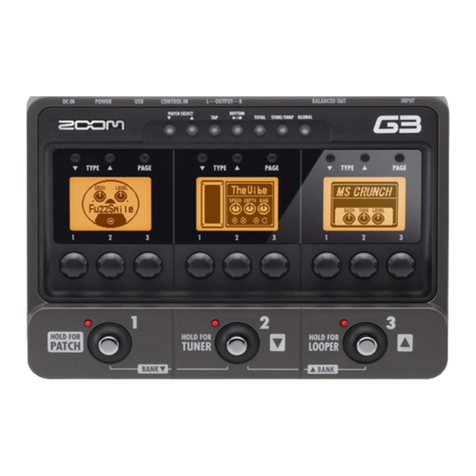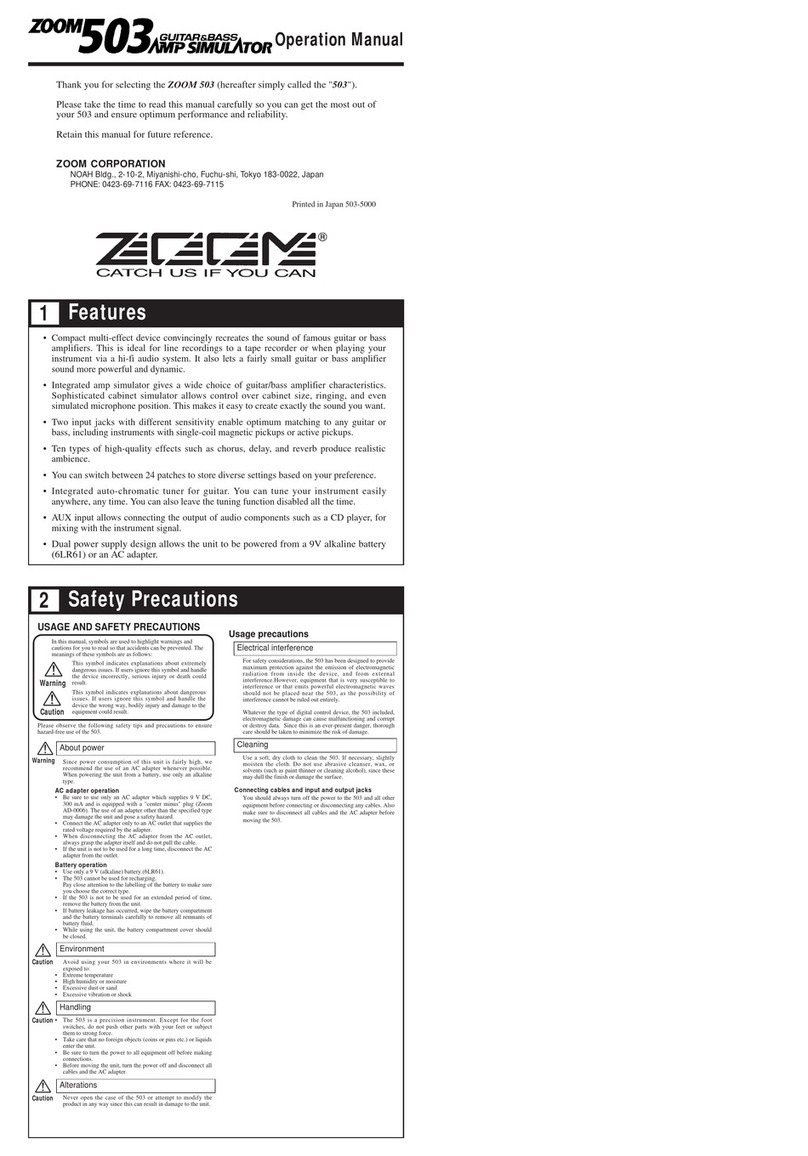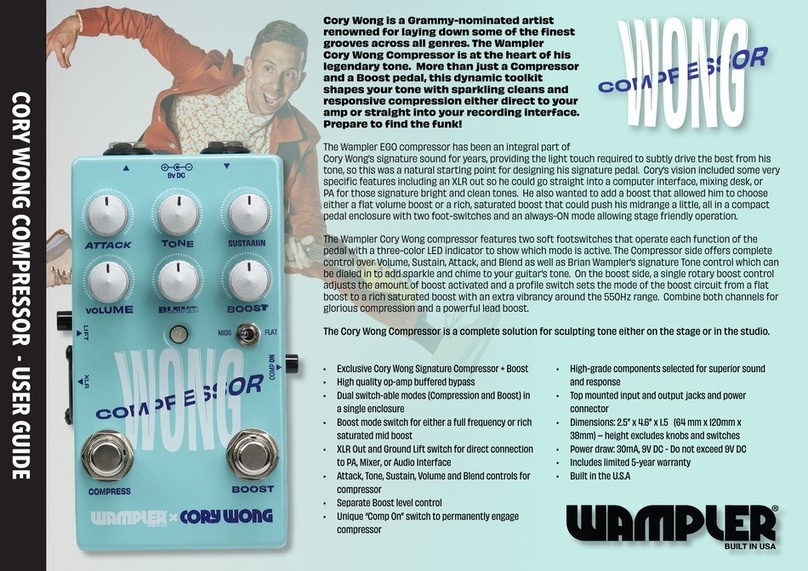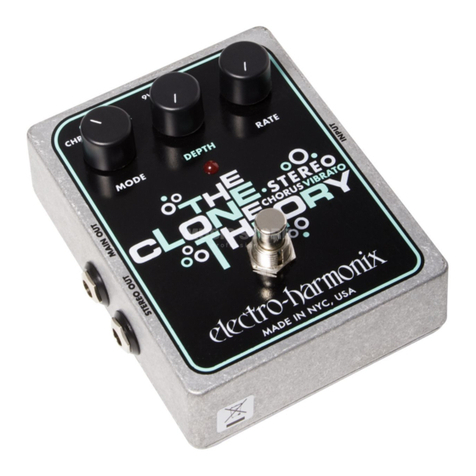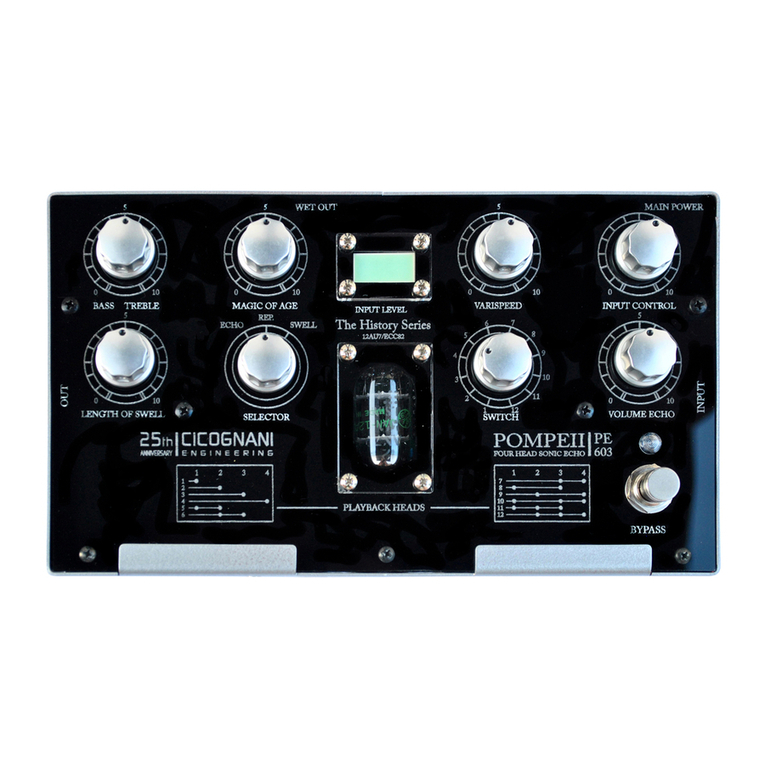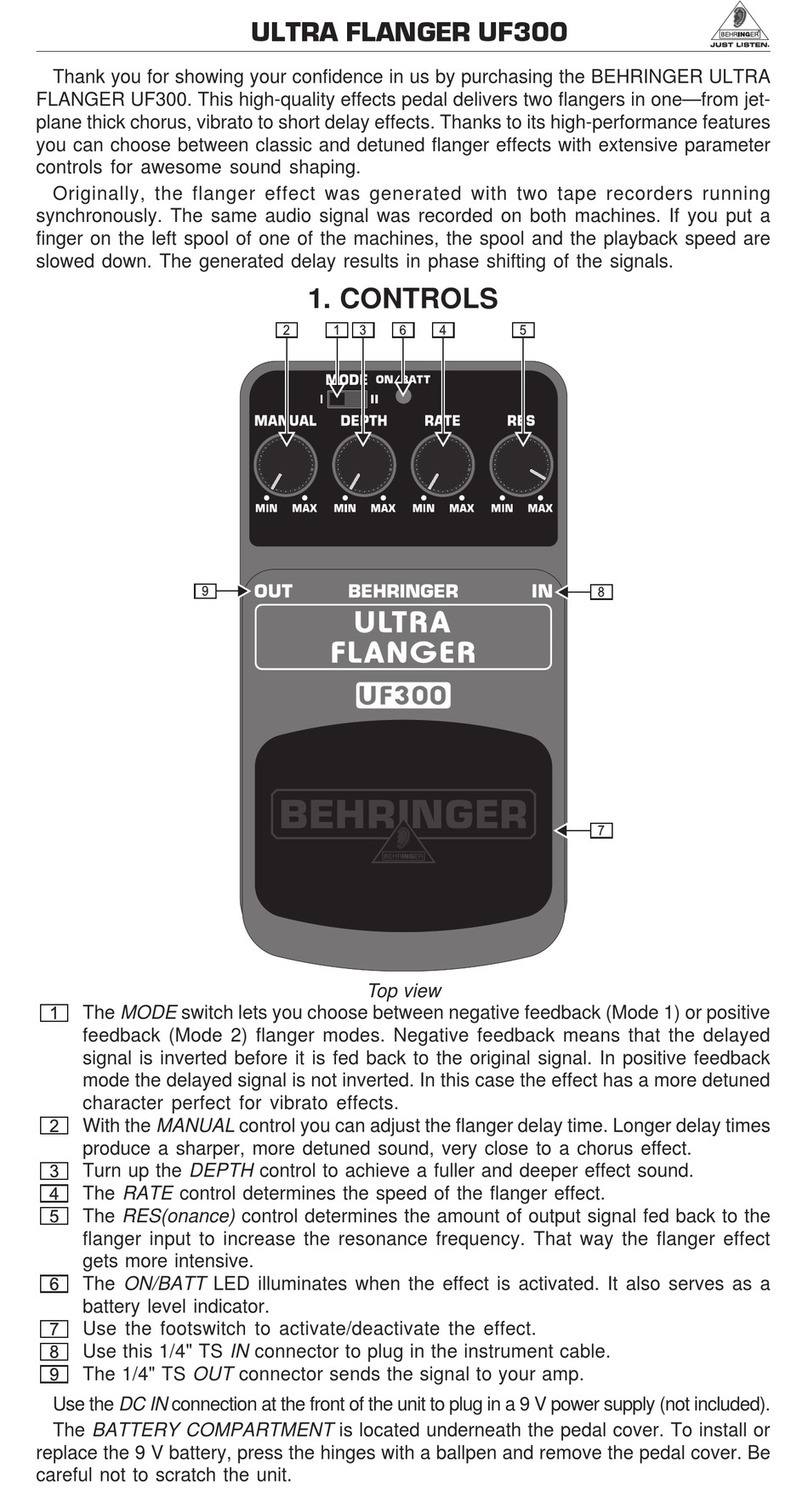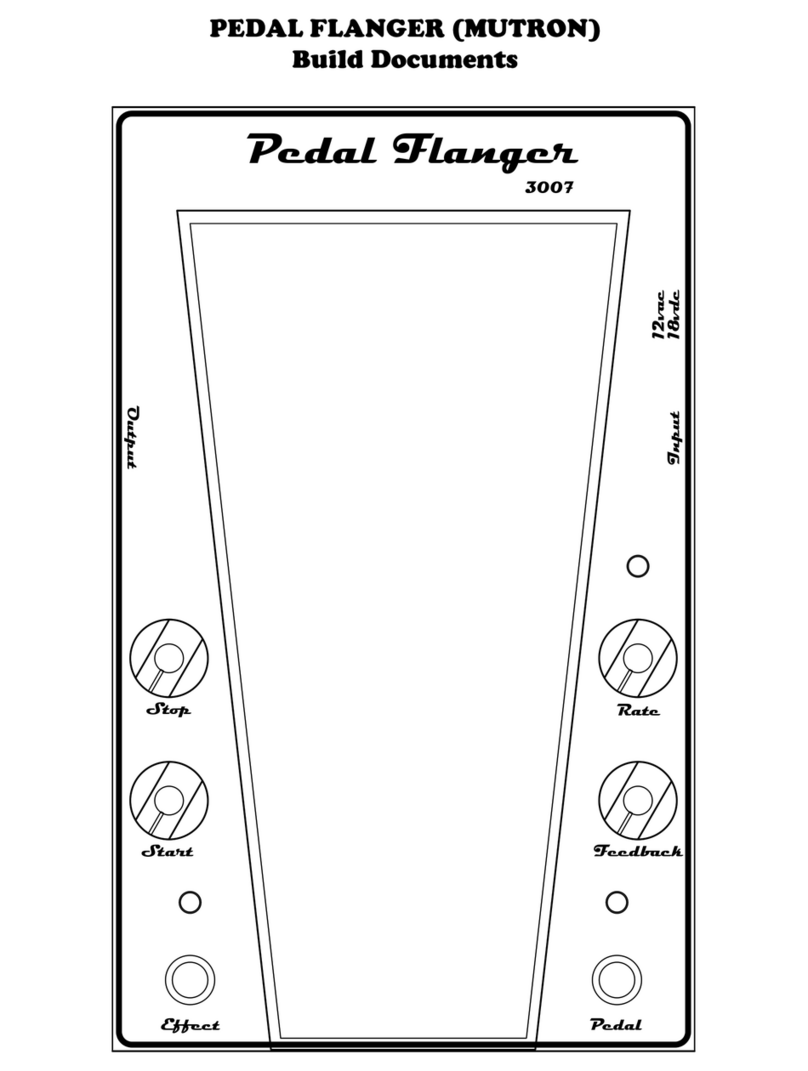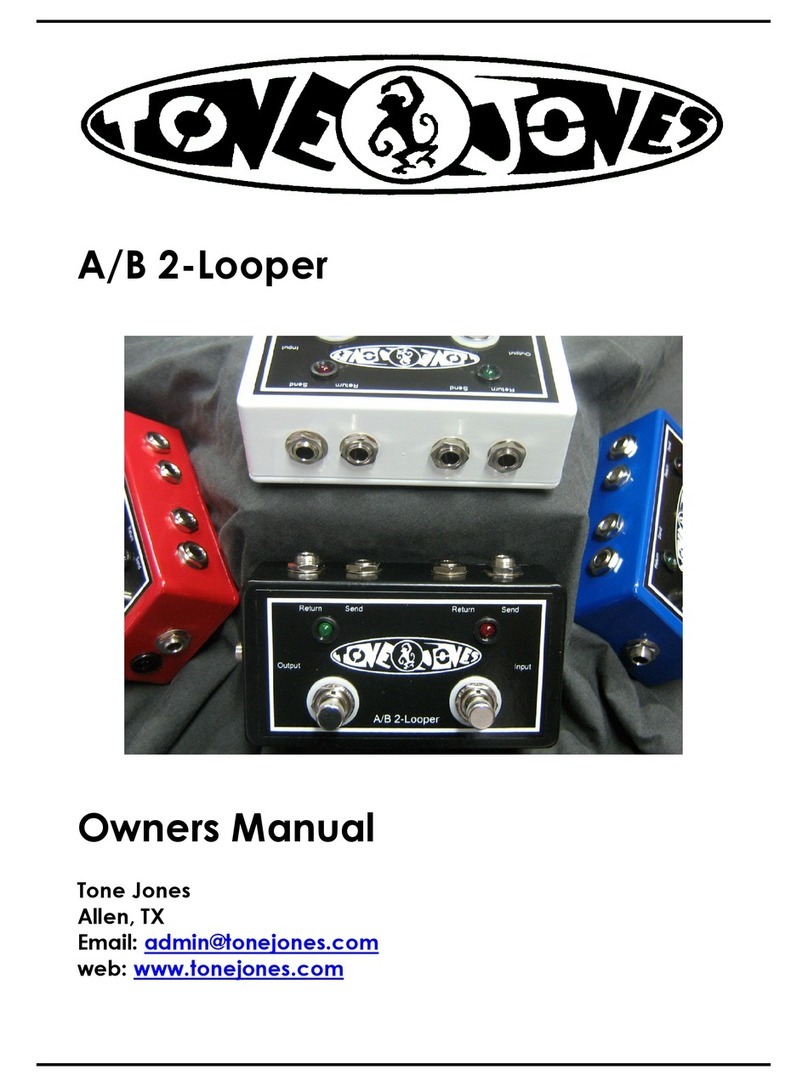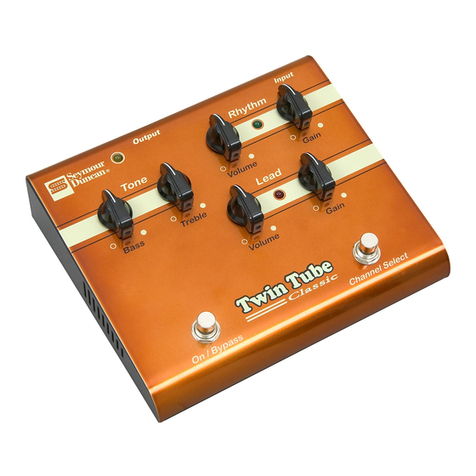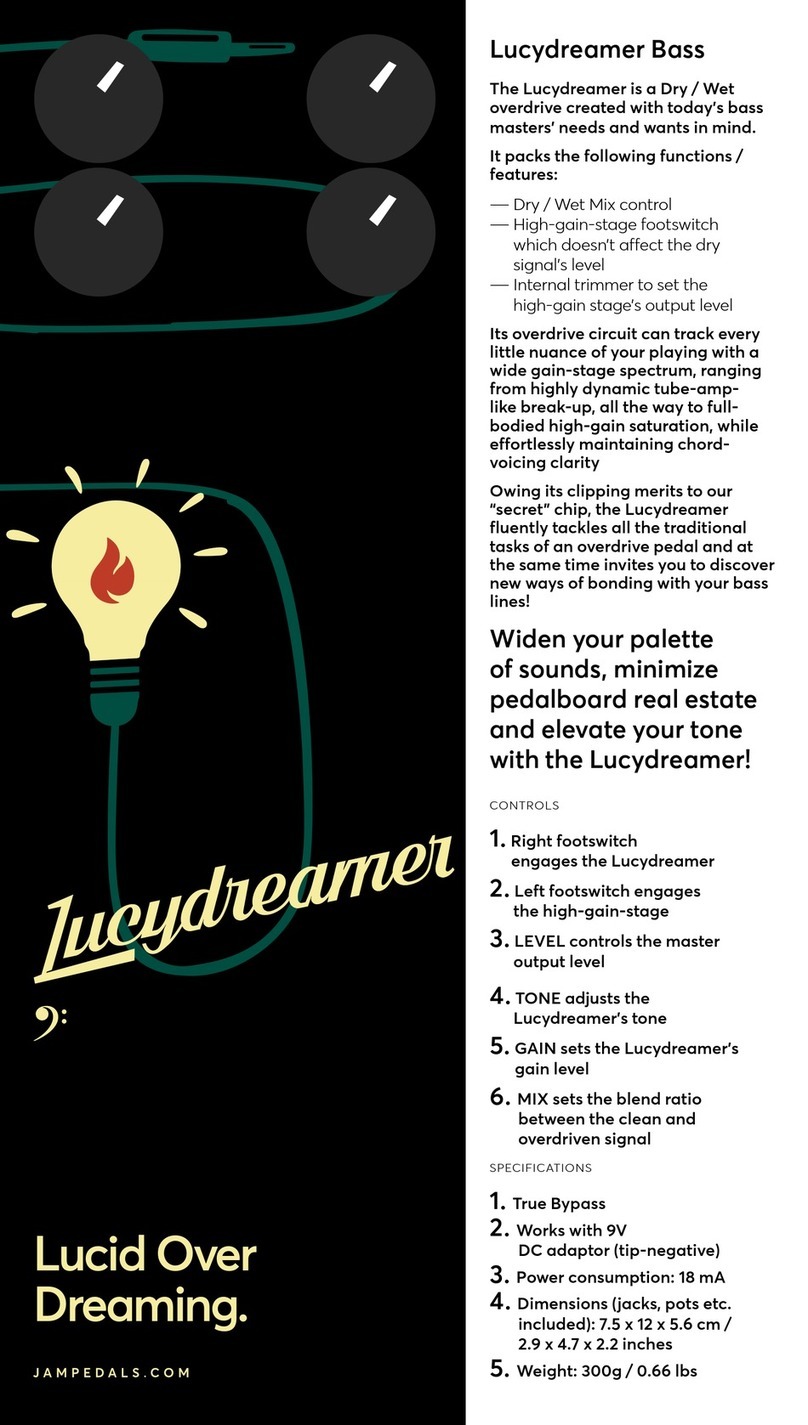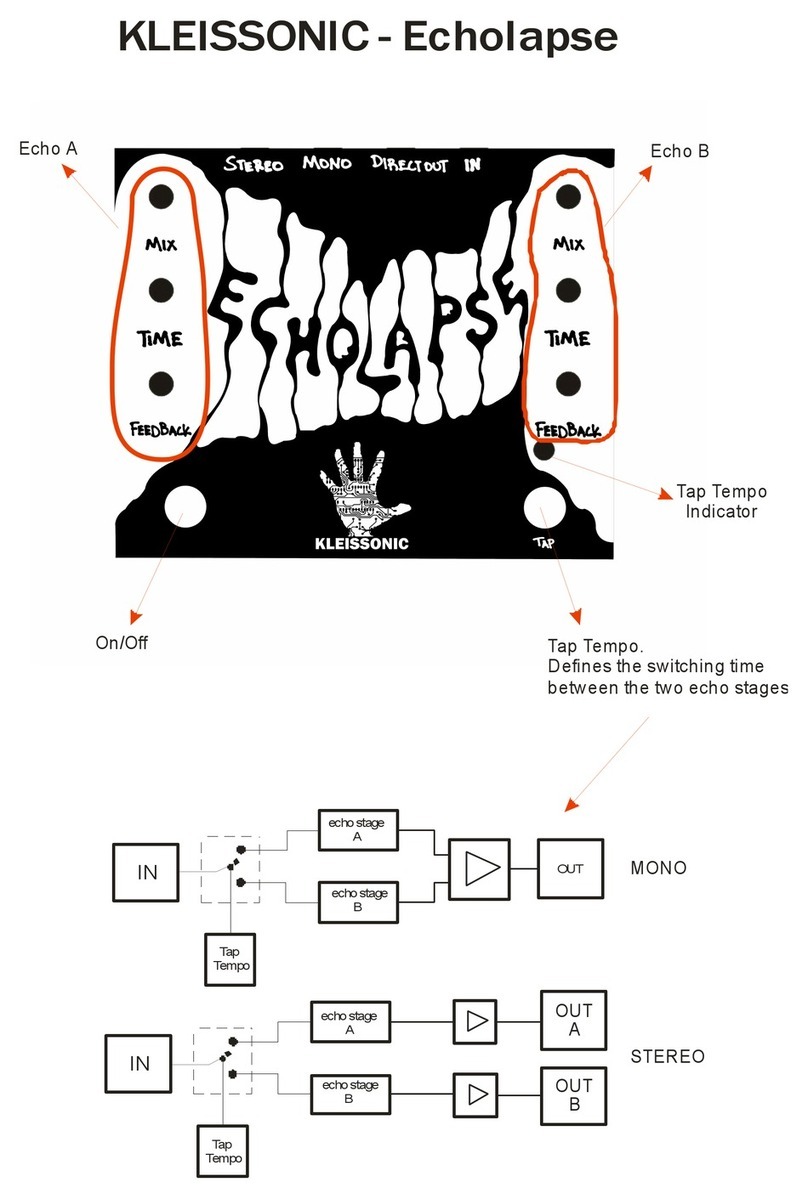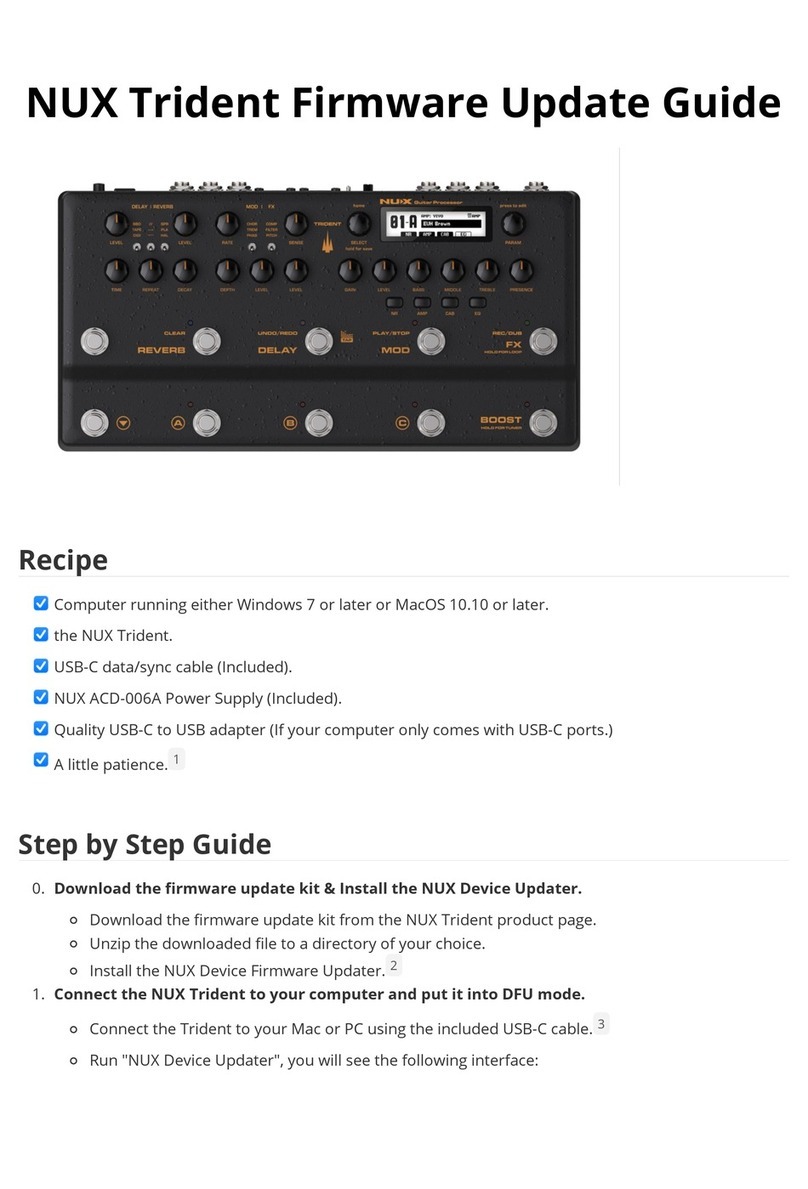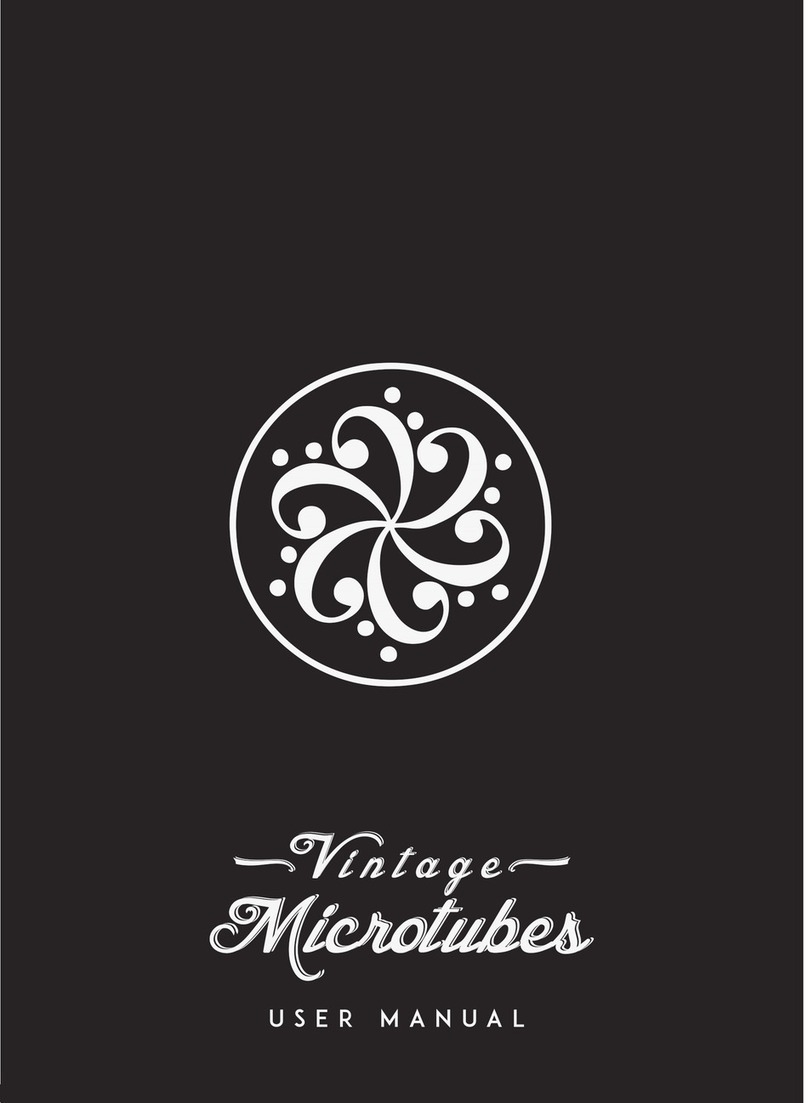Zoom 8080 User manual

Operation Manual
®
CONTROL
PEDAL
CONTROL
PEDAL
CONTROL
SWITCH
DECREASE
–(TAP/HOLD)
INCREASE
USER
FUNCTION
BANK
MAX
CONTROL
SWITCH
INDICATOR
1/2
MIN
BLINK
(DLY:TAP)
COMP EFF1 DIST EQ EFF2 EFF3 DLY REV TOTAL
GROUP
COMPARE
STORE
(EXECUTE) EDIT
EXIT UTILITY
PAGE TYPE
–+
PRESENCE OUTPUT
34
12
MAXMIN
MAXMIN
MAXMIN
MAXMIN
FINE TUNE
GROUP.BANK
:USER :PRESET :BOTH
88
..
U P .
Super
ADVANCED GUITAR EFFECTS PROCESSOR

Thank you for selecting the ZOOM SUPER PLAYER 8080 (hereafter simply called the "8080").
The 8080 is a sophisticated multi-effect device with the following features and functions:
• 47 types of high-quality single effects produced by two new-generation Zoom
DSP ZFx-2 chips. Up to 10 effects can be combined for simultaneous use, with
flexible patching arrangements. Virtually unlimited possibilities let you create
your ultimate guitar sound.
• Large internal memory holds 150 superb preset patches programmed by top-
notch professionals, plus 50 user- definable patches.
• Many effects simulate the sound of famous vintage effects that are hard to find
nowadays. Faithful recreation even includes the operation 'feel'.
• Seamless patch change lets you activate a new patch while the old patch still
reverberates, ensuring smooth transitions.
• Dedicated analog circuitry for various distortion effects. Built-in amp simulator
maintains dynamic guitar sound also during line recording and headphone
monitoring.
• Patches can include external effect on/off setting and external amp channel
selection.
• Four data entry knobs and an array of large foot switches allow easy control and
adjustment with an analog touch. Even musicians who have so far only used
compact effects will instantly feel at home.
• Integrated auto-chromatic guitar tuning function with tuning meter allows quick
and precise tuning of instruments on stage.
• Three real-time control circuits and two control pedals can be used for pedal
wah, pedal pitch shifter and any other effect parameter or level setting. Separate
control switches allow step-by-step adjustment.
Please take the time to read this manual carefully, in order to get the most out of your 8080 and to
ensure optimum performance and reliability.
1■

The pages explaining operation steps are organized as follows.
The following symbols are used in this manual.
[Note] Important warnings and information about points to
consider and possible problems
[Hint] Additional information regarding useful and convenient
functions and usage steps
[Refer to p. ] Indicates a page where related information can be found.
■ 2
Organization of This Manual
Use the
to select a bank from
0-9.
In this condition, the patch is not yet
selected.
BANK / switches
P0 P9
Use the 1-5
to select the patch
number.
The indicator of the foot switch
lights up and the respective patch
becomes active.
Foot switches
3
11
8080 Basic Operation
In Play mode, you can select from among 100 patches (one PRESET group A-C with 50 patches and the USER
group with 50 patches).
Selecting a patch
Use the to
select the group.
U: Patches from USER group only
P: Patches from PRESET group
only
U. or P.: Patches from both groups
With each push of the key, the
setting cycles through the above
modes.
GROUP key
1
USER PRESET BOTH
BOTH
CONTROL
PEDAL
CONTROL
PEDAL
CONTROL
SWITCH
DECREASE
–(TAP/HOLD)
INCREASE
USER
FUNCTION
BANK
MAX
CONTROL
SWITCH
INDICATOR
1/2
MIN
BLINK
(DLY:TAP)
COMP EFF1 DIST EQ EFF2 EFF3 DLY REV TOTAL
STORE
(EXECUTE) EDIT
EXIT UTILITY
PAGE TYPE
–+
PRESENCE OUTPUT
34
12
MAXMIN
MAXMINMAXMIN
MAXMIN
GROUP
COMPARE
FINE TUNE
GROUP.BANK
:USER :PRESET :BOTH
U P .
Super
ADVANCED GUITAR EFFECTS PROCESSOR
3
2
1
Beacon
Foot switches 1-5
GROUP
COMPARE
GROUP key
BANK / switches
BANK
P9
For information on how to switch between the PRESET groups A-C, see page 35.
N
O
✎
Operation key
or foot switch
Simple step-by-step
instructions
Detailed explanation
Function described on this page
Hints and precautions
Graphical Symbols Used in This Manual
N
✎
HINTHINT

In this manual, symbols are used to highlight warnings and
cautions for you to read so that accidents can be prevented.
The meanings of these symbols are as follows:
This symbol indicates explanations
about extremely dangerous matters. If
users ignore this symbol and handle
the device the wrong way, serious
injury or death could result.
This symbol indicates explanations
about dangerous matters. If users
ignore this symbol and handle the
device the wrong way, bodily injury
and damage to the equipment could
result.
Please observe the following safety tips and precautions
to ensure hazard-free use of the 8080.
• Power requirements
The 8080 is powered by the supplied AC adapter . To
prevent malfunction and safety hazards, Do not use any
other kind of AC adapter.
When using the 8080 in an area with a different line
voltage, please consult your local ZOOM distributor
about acquiring a proper AC adapter.
• Environment
Avoid using your 8080 in environments where it will be
exposed to:
• Extreme temperature
• High humidity or moisture
• Excessive dust or sand
• Excessive vibration or shock
• Handling
Since the 8080 is a precision electronic device, avoid
applying excessive force to the switches and buttons.
Also take care not to drop the unit, and do not subject it
to shock or excessive pressure.
• Alterations
Never open the case of the 8080 or attempt to modify the
product in any way since this can result in damage to the
unit.
• Connecting cables and input and
output jacks
You should always turn off the power to the 8080 and all
other equipment before connecting or disconnecting any
cables. Also make sure to disconnect all cables and the
AC adapter before moving the 8080.
• Electrical interference
For safety considerations, the 8080 has been designed to
provide maximum protection against the emission of
electromagnetic radiation from inside the device, and from
external interference.However, equipment that is very
susceptible to interference or that emits powerful
electromagnetic waves should not be placed near the 8080, as
the possibility of interference cannot be ruled out entirely.
Whatever the type of digital control device, the 8080 included,
electromagnetic damage can cause malfunctioning, and can
corrupt or destroy data. Since this is an ever-present danger,
thorough care should be taken to minimize the risk of damage.
• Cleaning
Use a soft, dry cloth to clean the 8080. If necessary, slightly
moisten the cloth. Do not use abrasive cleanser, wax, or
solvents (such as paint thinner or cleaning alcohol), since these
may dull the finish or damage the surface.
Please keep this manual in a convenient place for future
reference.
3■
USAGE AND SAFETY PRECAUTIONS
Usage PrecautionsSafety Precautions
Warning
Caution
Warning
Caution
Caution
Caution
Caution

Basic Operation
Names of Parts •••••••••••••••••••••••••••••••••••••••••••••••••••••••• 6
Top Panel View •••••••••••••••••••••••••••••••••••••••••••••••••••••• 6
Rear Panel View ••••••••••••••••••••••••••••••••••••••••••••••••••••• 6
Connection Examples ••••••••••••••••••••••••••••••••••••••••••• 7
Outline of the 8080 ••••••••••••••••••••••••••••••••••••••••••••••••• 8
Effect module configuration ••••••••••••••••••••••••••••••••••• 8
Patches •••••••••••••••••••••••••••••••••••••••••••••••••••••••••••••••••••• 8
Modes ••••••••••••••••••••••••••••••••••••••••••••••••••••••••••••••••••••• 9
Preparations •••••••••••••••••••••••••••••••••••••••••••••••••••••••••••• 9
Trying Out a Patch (Play Mode Operation) •••••••• 10
Indications in Play mode •••••••••••••••••••••••••••••••••••••• 10
Selecting a patch ••••••••••••••••••••••••••••••••••••••••••••••••••• 11
Effect Module On/Off Switching ••••••••••••••••••••••••• 12
Using the bypass/mute function ••••••••••••••••••••••••••• 13
Using the Auto tuner function •••••••••••••••••••••••••••••• 14
Calibrating the tuner reference pitch •••••••••••••••••••• 15
Adjusting the patch level •••••••••••••••••••••••••••••••••••••• 16
Advanced Operation
Editing a Patch (Edit Mode Operation) ••••••••••••••••••• 18
Activating the Edit mode •••••••••••••••••••••••••••••••••••••• 18
Indications in Edit mode ••••••••••••••••••••••••••••••••••••••• 19
Switching modules on and off •••••••••••••••••••••••••••••• 20
Changing the parameter settings ••••••••••••••••••••••••••• 21
Comparing an edited patch with its original
condition •••••••••••••••••••••••••••••••••••••••••••••••••••••••••••• 22
Storing an edited patch ••••••••••••••••••••••••••••••••••••••••• 23
Using the RTM Function ••••••••••••••••••••••••••••••••••••• 24
Using the CONTROL pedals for RTM •••••••••••••••• 24
Using the CONTROL switches for RTM ••••••••••••• 26
Tapping input of delay time •••••••••••••••••••••••••••••••••• 28
Delay hold ••••••••••••••••••••••••••••••••••••••••••••••••••••••••••••• 30
Utility Mode •••••••••••••••••••••••••••••••••••••••••••••••••••••••••••• 32
Switching between Utility mode and
Play mode ••••••••••••••••••••••••••••••••••••••••••••••••••••••••••• 32
Amp simulator settings: pages 1, 2 ••••••••••••••••••••••• 33
USER FUNCTION switch settings: page 3 ••••••••• 33
MIDI settings: pages 4 - 6 •••••••••••••••••••••••••••••••••••• 34
Foot switch settings: pages 7, 8 •••••••••••••••••••••••••••• 35
Switching PRESET groups A/B/C: page 9 ••••••••••• 35
Using the USER FUNCTION Switch •••••••••••••••• 36
To switch between Play mode and Manual mode
with the USER FUNCTION switch ••••••••••••••••••• 36
Using the USER FUNCTION switch to call up
a bank or patch •••••••••••••••••••••••••••••••••••••••••••••••••••••• 38
Using the USER FUNCTION switch to
select PRESET A/B/C ••••••••••••••••••••••••••••••••••••••• 40
Other Functions •••••••••••••••••••••••••••••••••••••••••••••••••••• 41
Controlling an external effect device •••••••••••••••••••• 41
Controlling an external amplifier ••••••••••••••••••••••••• 42
Returning the 8080 to the factory
default condition ••••••••••••••••••••••••••••••••••••••••••••••••• 44
Effect Types and Parameters
Effect Modules of the 8080 •••••••••••••••••••••••••••••••• 46
CMP (Compressor) Module ••••••••••••••••••••••••••••••• 47
EFF1 Module •••••••••••••••••••••••••••••••••••••••••••••••••••••••••• 48
DIST (Distortion) Module •••••••••••••••••••••••••••••••••••• 50
EQ Module •••••••••••••••••••••••••••••••••••••••••••••••••••••••••••••• 54
EFF2 Module •••••••••••••••••••••••••••••••••••••••••••••••••••••••••• 55
EFF3 Module •••••••••••••••••••••••••••••••••••••••••••••••••••••••••• 58
DLY (Delay) Module ••••••••••••••••••••••••••••••••••••••••••••• 60
REV (Reverb) Module •••••••••••••••••••••••••••••••••••••••••• 62
TOTAL Module •••••••••••••••••••••••••••••••••••••••••••••••••••••• 63
APPENDIX
MIDI Implementation •••••••••••••••••••••••••••••••••••••••••• 66
Specifications ••••••••••••••••••••••••••••••••••••••••••••••••••••••• 67
Troubleshooting •••••••••••••••••••••••••••••••••••••••••••••••••••• 68
MIDI Implementation Chart
■ 4
Contents

Names of Parts••••••••••••••••••••••••••••••••••••••••••••••••••••••••••••••••••••••••••••••••••••••••••••••••••••••••••••••••••••••••••••••••••••••••••••••••••••••••••••• 6
Top Panel View••••••••••••••••••••••••••••••••••••••••••••••••••••••••••••••••••••••••••••••••••••••••••••••••••••••••••••••••••••••••••••••••••••••••••••••••••••••••••••••••••••••• 6
Rear Panel View•••••••••••••••••••••••••••••••••••••••••••••••••••••••••••••••••••••••••••••••••••••••••••••••••••••••••••••••••••••••••••••••••••••••••••••••••••••••••••••••••••• 6
Connection Examples•••••••••••••••••••••••••••••••••••••••••••••••••••••••••••••••••••••••••••••••••••••••••••••••••••••••••••••••••••••••••• 7
Outline of the 8080••••••••••••••••••••••••••••••••••••••••••••••••••••••••••••••••••••••••••••••••••••••••••••••••••••••••••••••••••••••••••••••••••••••••••• 8
Effect module configuration••••••••••••••••••••••••••••••••••••••••••••••••••••••••••••••••••••••••••••••••••••••••••••••••••••••••••••••••••••••• 8
Patches•••••••••••••••••••••••••••••••••••••••••••••••••••••••••••••••••••••••••••••••••••••••••••••••••••••••••••••••••••••••••••••••••••••••••••••••••••••••••••••••••••••••••••••••••••••••••••••••••••••• 8
Modes••••••••••••••••••••••••••••••••••••••••••••••••••••••••••••••••••••••••••••••••••••••••••••••••••••••••••••••••••••••••••••••••••••••••••••••••••••••••••••••••••••••••••••••••••••••••••••••••••••••••••• 9
Preparations••••••••••••••••••••••••••••••••••••••••••••••••••••••••••••••••••••••••••••••••••••••••••••••••••••••••••••••••••••••••••••••••••••••••••••••••••••••••••••••••••••••••••••••••••• 9
Trying Out a Patch (Play Mode Operation)•••••••••••••••••••••••••••••• 10
Indications in Play mode•••••••••••••••••••••••••••••••••••••••••••••••••••••••••••••••••••••••••••••••••••••••••••••••••••••••••••••••••••••••••••••• 10
Selecting a patch••••••••••••••••••••••••••••••••••••••••••••••••••••••••••••••••••••••••••••••••••••••••••••••••••••••••••••••••••••••••••••••••••••••••••••••••••••••••••• 11
Effect Module On/Off Switching••••••••••••••••••••••••••••••••••••••••••••••••••••••••••••••••••••••••••••••••••••••••••••••••• 12
Using the bypass/mute function••••••••••••••••••••••••••••••••••••••••••••••••••••••••••••••••••••••••••••••••••••••••••••••• 13
Using the Auto tuner function•••••••••••••••••••••••••••••••••••••••••••••••••••••••••••••••••••••••••••••••••••••••••••••••••••••••••• 14
Calibrating the tuner reference pitch••••••••••••••••••••••••••••••••••••••••••••••••••••••••••••••••••••••••••••••• 15
Adjusting the patch level•••••••••••••••••••••••••••••••••••••••••••••••••••••••••••••••••••••••••••••••••••••••••••••••••••••••••••••••••••••••••••••• 16
Basic Operation

■ 6
Basic Operation
Names of Parts
CONTROL
PEDAL
CONTROL
PEDAL
CONTROL
SWITCH
DECREASE
–(TAP/HOLD)
INCREASE
USER
FUNCTION
BANK
MAX
CONTROL
SWITCH
INDICATOR
1/2
MIN
BLINK
(DLY:TAP)
COMP EFF1 DIST EQ EFF2 EFF3 DLY REV TOTAL
GROUP
COMPARE
STORE
(EXECUTE) EDIT
EXIT UTILITY
PAGE TYPE
–+
PRESENCE OUTPUT
34
12
MAXMIN
MAXMINMAXMIN
MAXMIN
FINE TUNE
BANK / TUNER
:USER :PRESET :BOTH
U0
U P .
Super
ADVANCED GUITAR EFFECTS PROCESSOR
MAX
CONTROL
SWITCH
INDICATOR
1/2
MIN
BLINK
(DLY:TAP)
COMP EFF1 DIST EQ EFF2 EFF3 DLY REV TOTAL
GROUP
COMPARE
STORE
(EXECUTE) EDIT
EXIT UTILITY
PAGE TYPE
–+
PRESENCE OUTPUT
34
12
MAXMIN
MAXMINMAXMIN
MAXMIN
FINE TUNE
U0
Super
ADVANCED GUITAR EFFECTS PROCESSOR
MAX
CONTROL
SWITCH
INDICATOR
1/2
MIN
BLINK
(DLY:TAP)
COMP EFF1 DIST EQ EFF2 EFF3 DLY REV TOTAL
GROUP
COMPARE
STORE
(EXECUTE) EDIT
EXIT UTILITY
PAGE TYPE
–+
PRESENCE OUTPUT
34
12
MAXMIN
MAXMINMAXMIN
MAXMIN
FINE TUNE
U0
Super
ADVANCED GUITAR EFFECTS PROCESSOR
GROUP.BANK
:USER :PRESET :BOTH
U P
GROUP. BANK
:USER :PRESET :BOTH
U P .
Enlarged Operation Panel View
PRESENCE control
CONTROL pedal 1
CONTROL switches (INCREASE/DECREASE)
CONTROL pedal 2
BANK / switches USER FUNCTION switch TAP/HOLD INDICATOR
Foot switches 1-5
Beacon
Tuning meter Display Data entry knobs 1-4
CONTROL SWITCH
INDICATOR
Effect keys
STORE/EXECUTE key
GROUP/COMPARE key
EDIT/EXIT key
UTILITY/PAGE key
TYPE -/+ keys
OUTPUT control
MODEL 8080 ZOOM CORPORATION
MADE IN JAPAN/FABRIQUE AU JAPON
Super
SERIAL NO.
INPUT GAIN INPUT
HML SEND RETURN +4dB
–20dB
EXTERNAL DIST OUTPUT
PHONES R L/MONO EXT
CTRL OUT
+4dB
–20dB
DC9V1.0A POWER MIDI OUT
MIDI OUT jack
INPUT GAIN SELECT switch
INPUT jack
EXTERNAL DIST SEND jack
EXTERNAL DIST RETURN jack EXTERNAL DIST RETURN GAIN switch
PHONES jack L/MONO/R OUTPUT jacks
OUTPUT LEVEL GAIN switch
EXTERNAL CONTROL jack
AC ADAPTOR jack
POWER switch
Top Panel View
Rear Panel View

7■
8080 Basic Operation
Connection Examples
MODEL 8080 ZOOM CORPORATION
MADE IN JAPAN/FABRIQUE AU JAPON
Super
SERIAL NO.
INPUT GAIN INPUT
HML SEND RETURN +4dB
–20dB
EXTERNAL DIST OUTPUT
PHONES R L/MONO EXT
CTRL OUT
+4dB
–20dB
DC9V1.0A POWER MIDI OUT
L/MONO OUTPUT
EXTERNAL CONTROL
FOOT SWITCH INPUT
EXTERNAL
DIST SEND
IN OUT
INPUT
L OUTPUTR OUTPUT
EXTERNAL
DIST RETURN
MIDI IN
MIDI cable
MIDI OUT
PHONES
Connection example 1: instrument/guitar amplifier connection
When using only one guitar amplifier, connect the L/MONO OUTPUT jack of the
8080 to the input of the guitar amplifier. In this case, the L and R signals of stereo
effects will be combined in the output.
When using two guitar amplifiers, connect the L and R OUTPUT jacks of the
8080 to the inputs of the guitar amplifiers.
Set the OUTPUT LEVEL GAIN switch to the position which matches the input
sensitivity of the connected equipment. For connection to a guitar amplifier, the
"-20 dB" position will normally be best, whereas professional effect devices and
mixing consoles will work better with the "+4 dB" setting.
NO
✎
Connection example 2: external effect/preamplifier connection
When wishing to control the on/off condition of an external distortion effect
or preamplifier or similar, connect the effect device in the EXTERNAL
DIST SEND and EXTERNAL DIST RETURN loop ( p. 41).
Set the EXTERNAL DIST RETURN GAIN switch to the position which matches
the output level of the connected equipment. For use with a compact
effect device, the "-20 dB" position will normally be best, whereas
professional effect devices and guitar preamplifiers will work better with
the "+4 dB" setting.
N
O
✎
Connection example 4:
MIDI connection
When wishing to control the
programs of a MIDI-compatible
external distortion effect or
preamplifier or similar, connect the
MIDI jack of the device to the
MIDI OUT jack of the 8080, using
a MIDI cable( p.34).
Connection example 3:
external guitar amplifier
connection
When wishing to control
channel switching of a guitar
amplifier using the foot switches
of the 8080, connect the
EXTERNAL CONTROL jack
of the 8080 with the foot switch
jack of the guitar amplifier,
using either a stereo or mono
cable ( p. 42).

This section explains what the 8080 is and what it can do. You will also find explanations of some important
terms here.
The 8080 is a multi-effect device made up of eight different effect modules (effect blocks). Each effect module
acts like a single compact effect. The following modules are available:
• COMP ••••••••••••• Compressor effects for processing the sound level
• EFF1 ••••••••••••••••• Equalizer effects and wah/modulation effects with strong characteristics.
Can be inserted before or after the DIST module.
• DIST •••••••••••••••••• Analog distortion effects
• EQ ••••••••••••••••••••••• Basic equalizer effects
• EFF2 ••••••••••••••••• Modulation-type effects for changing pitch and creating special effects
• EFF3 ••••••••••••••••• Standard modulation-type effects such as flanger and chorus
• DLY •••••••••••••••••••• Stereo delay effects
• REV •••••••••••••••••••• Reverberation effects
Almost all effect modules contain several variations of an effect (effect types), out of which the user can select
the most suitable one. The illustration below shows the signal flow in the 8080 and the effect types for the
various effect modules.
Internal settings of the 8080 are called patches which can be stored in memory and called up at any time. A patch
consists of the parameter settings for the various effect modules, plus information about the patch level, control
pedal and control switch settings, EFF1 routing, EFF2/EFF3 connection type, etc. The section enclosed in a
dotted line in the above illustration is a patch.
The 8080 divides patches into four groups: one USER group for
patches that can be changed by the user and three PRESET
groups (A-C) for patches that have been programmed at the
factory. Each group contains 50 patches, resulting in a total of
200 patches. The 8080 allows simultaneous use of one group
from the PRESET A-C groups and one patch from the USER
group.
Within a group, patches are divided into "banks" of five patches
each. Every group has ten such banks (numbered 0- 9).
Patches
Effect module configuration
■ 8
Basic Operation
Outline of the 8080
Compressor 1
"Vintage"Compressor2
Limiter
1-Band Parametric EQ
Pedal-Wah
"Vintage"Auto-Wah1
Auto-Wah2
"Vintage"Phaser1
"Vintage"Vibe
Octaver
External DIST
Acoustic
Rhythm
"Vintage"OverDrive
Tube OverDrive
Blues OverDrive
"Vintage"DIST P
"Vintage"DIST M
"Vintage"Fuzz B
"Vintage"Fuzz-F
LeadDriver
Metal Distortion
3-Band Equalizer Pedal Pitch Shifter
2-voice Pitch Shifter
Pitch Shifter-Delay
2-voice Harmonized Pitch Shifter
Pitch Bender
Slow Attack
Metallic
Flanger1
"Vintage"Flanger2
Phaser2
Chorus1
"Vintage"Chorus2
Vibrato
Step
Tremolo/Pan
Normal Delay
Twin Delay
Hold Delay
"Vintage"Analog Delay
Reverb Hall
Reverb Room
PingPong Delay
COMP EFF 1 DIST EQ EFF2 EFF3 DLY REV
TOTAL
PATCH LEVEL
L/R
OUTPUT
INPUT
EXTERNAL DIST SEND/RETURN
ZNR Guitar Amp Simulator
The EFF1 module can be inserted before or after the DIST module.
The EFF2 and EFF3 modules can be connected in series or parallel.
NO
✎
You can use the USER FUNCTION switch on the top panel
to select PRESET groups A-C ( p. 40).
HINTHINT
012345
12345
912345
012345
12345
912345
012345
12345
912345
012345
12345
912345
USER group PRESET group A
Patch No.BANK Patch No.BANK
PRESET group B
Patch No.BANK
PRESET group C
Patch No.BANK
Groups that can be used together

The 8080 has the following three main operation modes:
• Play mode •••••••••••• In this mode, you select patches and use them for playing. You can also
temporarily turn effects off, tune your instrument, and perform some other
functions.
• Edit mode •••••••••••• In this mode, you can edit (change) the parameters of the effect modules in
the currently selected patch.
• Utility mode ••••••••• In this mode, you can make amp simulator, MIDI, and other settings which
affect all patches.
Besides the above mentioned main operation modes, the 8080 also has a manual mode for turning effect modules off and on
with the foot switches during a performance, and the so-called initialize mode for resetting the unit to the factory defaults.
Preparations
Modes
HINTHINT
9■
Basic Operation
Turn power to the amplifier(s) off
and set the volume to minimum.
1
Connect the 8080 to the instrument,
amplifier(s) etc.
2
Plug the AC adapter of the 8080 into
an AC outlet.
3
Set the INPUT GAIN SELECT switch
on the rear panel of the 8080 to a
position which matches the output
level of the guitar.
Recommended switch settings are as
follows. Guitars with single-coil pickups:
"H", guitars with hum-bucking type
pickups: "M", guitars with active type
pickups: "L".
4
Turn the 8080 on.
5
Turn the amplifier(s) on.
6
Adjust the OUTPUT control of the
8080 to a suitable position and
adjust the level controls on the
instrument and the amplifier(s).
7
Use the PRESENCE control on the
8080 to adjust the timbre.
8
INPUT GAIN
HML
POWER
PRESENCE
OUTPUT
The settings of the OUTPUT and PRESENCE controls are not memorized.
NO
✎

The Play mode is the basic operation mode of the 8080, in which you select patches and use them while playing
your instrument. When the 8080 is turned on, the Play mode is automatically activated and patch number 1 of the
USER group/bank 0 is selected.
In Play mode, the beacon, display, and effect keys show the following information.
The patch names and values shown in the illustration are an example. The actual display may differ.
NO
✎
■ 10
Basic Operation
Indications in Play mode
GROUP.BANK
:USER :PRESET :BOTH
U0
U P .
Beacon Group Bank
Amp simulator on/off
Group
Bank Patch number
Patch name Patch level
Currently assigned
foot switch parameter
Currently assigned
CONTROL pedal 2 parameter
Currently assigned
CONTROL pedal 1 parameter
=USER
=PRESET A
=PRESET B
=PRESET C
Display
BLANK
=Amp simulator on
=Amp simulator off
Trying Out a Patch (Play Mode Operation)
Effect keys
Currently inactive effect module (out)
Currently active effect module (lit)
COMP EFF1 DIST EQ EFF2 EFF3 DLY REV TOTAL

Use the
to select a bank from
0-9.
In this condition, the patch is not yet
selected.
BANK / switches
P0 P9
Use the 1-5
to select the patch
number.
The indicator of the foot switch
lights up and the respective patch
becomes active.
Foot switches
3
11 ■
Basic Operation
In Play mode, you can select from among 100 patches (one PRESET group A-C with 50 patches and the USER
group with 50 patches).
Selecting a patch
Use the to
select the group.
U: Patches from USER group only
P: Patches from PRESET group
only
U. or P.: Patches from both groups
With each push of the key, the
setting cycles through the above
modes.
GROUP key
1
2
USER PRESET BOTH
BOTH
CONTROL
PEDAL
CONTROL
PEDAL
CONTROL
SWITCH
DECREASE
–(TAP/HOLD)
INCREASE
USER
FUNCTION
BANK
MAX
CONTROL
SWITCH
INDICATOR
1/2
MIN
BLINK
(DLY:TAP)
COMP EFF1 DIST EQ EFF2 EFF3 DLY REV TOTAL
STORE
(EXECUTE) EDIT
EXIT UTILITY
PAGE TYPE
–+
PRESENCE OUTPUT
34
12
MAXMIN
MAXMINMAXMIN
MAXMIN
GROUP
COMPARE
FINE TUNE
GROUP.BANK
:USER :PRESET :BOTH
U P .
Super
ADVANCED GUITAR EFFECTS PROCESSOR
3
2
1
Beacon
Foot switches 1-5
GROUP
COMPARE
GROUP key
BANK / switches
BANK
P9
For information on how to switch between the PRESET groups A-C, see page 35.
HINTHINT

Each patch of the 8080 is made up of several effect modules. Use the effect keys to switch the desired modules
on and off.
■ 12
Basic Operation
Effect Module On/Off Switching
Press any that
is lit (except the
TOTAL key).
In Play mode, the keys of effect
modules that are currently active are
lit, and the keys of modules that are
currently inactive are out. Pressing a
lit effect key turns that module off.
Effect key
1
Press the once
more. The key lights up and the module
becomes active again.
Other effect modules can be
switched off and on in the same
way.
Effect key
2
CONTROL
PEDAL
CONTROL
PEDAL
CONTROL
SWITCH
DECREASE
–(TAP/HOLD)
INCREASE
USER
FUNCTION
BANK
MAX
CONTROL
SWITCH
INDICATOR
1/2
MIN
BLINK
(DLY:TAP)
TOTAL
STORE
(EXECUTE) EDIT
EXIT UTILITY
PAGE TYPE
–+
PRESENCE OUTPUT
34
12
MAXMIN
MAXMINMAXMIN
MAXMIN
GROUP
COMPARE
FINE TUNE
Super
ADVANCED GUITAR EFFECTS PROCESSOR
COMP EFF1 DIST EQ EFF2 EFF3 DLY REV 1, 2
COMP EFF1 DIST EQ EFF2 EFF3 DLY REV
Effect keys
Display
COMP EFF1 DIST EQ
COMP EFF1 DIST EQ
When an effect module is switched off or on, the indication "é" appears on the display. This indicates that the currently
selected patch has been changed (edited).
The TOTAL module contains settings that are active for the entire patch. This module can therefore not be switched off.
Unless you store the new setting ( p. 23), any changes that you have made in the effect module on/off setting of a patch
will be lost when you select a different patch.
NO
✎
NO
✎
HINTHINT
01 8080LEAD LVL=100
AMP ¡VOL ™OFF ßHLD
01 8080LEAD LVL=100
é AMP ¡VOL ™OFF ßHLD

13 ■
Basic Operation
To set the 8080 to the
mute condition,
press
the 1-5
whose LED is lit (i.e.
the pedal switch that
was used to choose
the current patch) for
one second or more.
The output of the 8080 is cut off
and the indicator of the foot switch
flashes.
1'
Press the
once more to turn
the patch back on
again.
Normal Play mode can also be
restored by selecting a different
patch.
2
01 8080LEAD LVL=100
AMP ¡VOL ™OFF ßHLD
In the bypass condition, all effects of the 8080 are temporarily disabled, so that only the original sound is heard.
This is useful for example to check the overall sonic character of a patch.
In the mute condition, the effects of the 8080 as well as the original sound are disabled, so that the output is
muted. This is convenient for using the auto tuner function ( p. 14) without letting others hear the sound.
Using the bypass/mute function
CONTROL
PEDAL
CONTROL
PEDAL
CONTROL
SWITCH
DECREASE
–(TAP/HOLD)
INCREASE
USER
FUNCTION
BANK
MAX
CONTROL
SWITCH
INDICATOR
1/2
MIN
BLINK
(DLY:TAP)
COMP EFF1 DIST EQ EFF2 EFF3 DLY REV TOTAL
STORE
(EXECUTE) EDIT
EXIT UTILITY
PAGE TYPE
–+
PRESENCE OUTPUT
34
12
MAXMIN
MAXMINMAXMIN
MAXMIN
GROUP
COMPARE
FINE TUNE
Super
ADVANCED GUITAR EFFECTS PROCESSOR
1, 1', 2
Beacon Display
Foot switches 1-5
Foot switches
Foot switches
01 8080LEAD MUTE
TUNER CALIB=440Hz
--
--
Keep your foot more
tham one second
To set the 8080 to the
bypass condition,
briefly press
the 1-5
whose LED is lit (i.e.
the pedal switch that
was used to choose
the current patch).
All effects in the patch are now
bypassed and the original
instrument sound is heard. The
indicator of the foot switch flashes.
1
01 8080LEAD BYPASS
TUNER CALIB=440Hz
U0
--
--
Release your foot straight away
Foot switches

The 8080 incorporates an auto-chromatic tuner which makes it easy to tune your guitar. This function can be
used when the 8080 is in the bypass/mute condition.
■ 14
Basic Operation
Using the Auto tuner function
Press the
1-5 whose LED is lit
(i.e. the pedal switch
that was used to
choose the current
patch) to set the
8080 to the bypass or
mute condition.
The auto tuner can now be used.
1
Pick the open string
on the guitar you
want to tune.
The beacon shows the note which
is closest to the current pitch. Tune
the guitar to the desired pitch.
2
When the beacon
shows the desired
note, continue the
tuning process until
the FINE TUNE LED
of the tuning meter
lights up.
3
Press the
once more or select
a different patch to
revert to normal Play
mode.
Foot switches
4
CONTROL
PEDAL
CONTROL
PEDAL
CONTROL
SWITCH
DECREASE
–(TAP/HOLD)
INCREASE
USER
FUNCTION
BANK
MAX
CONTROL
SWITCH
INDICATOR
1/2
MIN
BLINK
(DLY:TAP)
COMP EFF1 DIST EQ EFF2 EFF3 DLY REV TOTAL
STORE
(EXECUTE) EDIT
EXIT UTILITY
PAGE
PRESENCE OUTPUT
34
12
MAXMIN
MAXMINMAXMIN
MAXMIN
GROUP
COMPARE
FINE TUNE
Super
ADVANCED GUITAR EFFECTS PROCESSOR
TYPE
–+
1, 4
Beacon
Foot switches 1-5
1, 3 Tuning meter
FINE TUNE
2
--
--
C
--
--
Foot switches
C=
C#=
D=
D#=
E=
F=
F#=
G=
G#=
A=
A#=
B=
FINE TUNE
FINE TUNE
Correctly tuned
Pitch too high
FINE TUNE
Pitch too low
For tuning on stage or other situations where the sound should not be heard, use the mute function.
NO
✎
U0

15 ■
Basic Operation
Press the
1-5 whose LED is lit
(i.e. the pedal switch
that was used to
choose the current
patch) to set the
8080 to the bypass or
mute condition.
1
Select the pitch with
4.
The indication "TUNER CALIB"
appears on the display, along with
the current value.
Calibration is possible within the
range from 435 to 445 Hz. Calibration
Data entry knob
2
Press the
once more or select
a different patch to
revert to normal Play
mode.
3
The reference pitch of the auto tuner in the 8080 can be adjusted as follows.
Calibrating the tuner reference pitch
CONTROL
PEDAL
CONTROL
PEDAL
CONTROL
SWITCH
DECREASE
–(TAP/HOLD)
INCREASE
USER
FUNCTION
BANK
MAX
CONTROL
SWITCH
INDICATOR
1/2
MIN
BLINK
(DLY:TAP)
COMP EFF1 DIST EQ EFF2 EFF3 DLY REV TOTAL
STORE
(EXECUTE) EDIT
EXIT UTILITY
PAGE
PRESENCE OUTPUT
34
1
MAXMIN
MAXMIN
MAXMIN
GROUP
COMPARE
FINE TUNE
Super
ADVANCED GUITAR EFFECTS PROCESSOR
TYPE
–+
MAXMIN
2
1, 3
Beacon
Foot switches 1-5
Display
2Data entry knob 2
MAXMIN
--
U0
Foot switches
Foot switches
The new reference pitch is stored automatically.
NO
✎
01 8080LEAD BYPASS
TUNER CALIB=440Hz
01 8080LEAD LVL=100
AMP ¡VOL ™OFF ßHLD
01 8080LEAD BYPASS
TUNER CALIB=440Hz

You can set the level independently for each patch. This is useful for example to differentiate between lead
sound and rhythm sound.
■ 16
Basic Operation
Adjusting the patch level
In Play mode, move
the 2 .
The value of "LVL" changes.
Data entry knob
1
Adjust data
2 to a
suitable level while
playing your
instrument.
2
CONTROL
PEDAL
CONTROL
PEDAL
CONTROL
SWITCH
DECREASE
–(TAP/HOLD)
INCREASE
USER
FUNCTION
BANK
MAX
CONTROL
SWITCH
INDICATOR
1/2
MIN
BLINK
(DLY:TAP)
COMP EFF1 DIST EQ EFF2 EFF3 DLY REV TOTAL
STORE
(EXECUTE) EDIT
EXIT UTILITY
PAGE TYPE
–+
PRESENCE OUTPUT
34
1
MAXMIN
MAXMIN
MAXMIN
GROUP
COMPARE
FINE TUNE
Super
ADVANCED GUITAR EFFECTS PROCESSOR
2MAXMIN
Display
1, 2 Data entry knob 2
MAXMIN
01 8080LEAD LVL= 80
é AMP ¡VOL ™OFF ßHLD
01 8080LEAD LVL= 90
é AMP ¡VOL ™OFF ßHLD
Data entry knob
When the data entry knob 2 is moved, the indication "E" appears on the display. This indicates that the currently selected
patch has been changed (edited).
The patch level determines the level for each individual patch and can be stored as a parameter ( p. 23).
NO
✎
NO
✎

Editing a Patch (Edit Mode Operation) ••••••••••••••••••••••••••••••• 18
Activating the Edit mode •••••••••••••••••••••••••••••••••••••••••••••••••••••••••••••••••••••••••••• 18
Indications in Edit mode ••••••••••••••••••••••••••••••••••••••••••••••••••••••••••••••••••••••••••••• 19
Switching modules on and off ••••••••••••••••••••••••••••••••••••••••••••••••••••••••••••••• 20
Changing the parameter settings ••••••••••••••••••••••••••••••••••••••••••••••••••••••• 21
Comparing an edited patch with its original condition ••••••• 22
Storing an edited patch •••••••••••••••••••••••••••••••••••••••••••••••••••••••••••••••••••••••••••••• 23
Using the RTM Function •••••••••••••••••••••••••••••••••••••••••••••••••••••••••••••• 24
Using the CONTROL pedals for RTM ••••••••••••••••••••••••••••••••••••••••••••• 24
Using the CONTROL switches for RTM •••••••••••••••••••••••••••••••••••••••• 26
Tapping input of delay time ••••••••••••••••••••••••••••••••••••••••••••••••••••••••••••••••••••• 28
Delay hold •••••••••••••••••••••••••••••••••••••••••••••••••••••••••••••••••••••••••••••••••••••••••••••••••••••••••••••• 30
Utility Mode ••••••••••••••••••••••••••••••••••••••••••••••••••••••••••••••••••••••••••••••••••••••••••••••••••••••• 32
Switching between Utility mode and Play mode •••••••••••••••••••• 32
Amp simulator settings: pages 1, 2 •••••••••••••••••••••••••••••••••••••••••••••••••• 33
USER FUNCTION switch settings: page 3 ••••••••••••••••••••••••••••••••• 33
MIDI settings: pages 4 - 6 •••••••••••••••••••••••••••••••••••••••••••••••••••••••••••••••••••••••• 34
Foot switch settings: pages 7, 8 ••••••••••••••••••••••••••••••••••••••••••••••••••••••••• 35
Switching PRESET groups A/B/C: page 9 ••••••••••••••••••••••••••••••••• 35
Using the USER FUNCTION Switch ••••••••••••••••••••••••••••• 36
To switch between Play mode and Manual mode
with the USER FUNCTION switch •••••••••••••••••••••••••••••••••••••••••••••••••••• 36
Using the USER FUNCTION switch to call up
a bank or patch ••••••••••••••••••••••••••••••••••••••••••••••••••••••••••••••••••••••••••••••••••••••••••••••••• 38
Using the USER FUNCTION switch to select
PRESET A/B/C •••••••••••••••••••••••••••••••••••••••••••••••••••••••••••••••••••••••••••••••••••••••••••••••••• 40
Other Functions •••••••••••••••••••••••••••••••••••••••••••••••••••••••••••••••••••••••••••••••••••••••• 41
Controlling an external effect device •••••••••••••••••••••••••••••••••••••••••••••••• 41
Controlling an external amplifier ••••••••••••••••••••••••••••••••••••••••••••••••••••••••••• 42
Returning the 8080 to the factory default condition •••••••••••• 44
Advanced Operation

In the Edit mode, you can change the parameters of the various effects, to create your own sound effects.
■ 18
Advanced Operation
Activating the Edit mode
In Play mode, select
the patch you want to
edit.
("Selecting a patch" p. 11).
1
Press the . The 8080 enters the Edit mode.
Pressing any effect key will cause
the key indicator to flash. This
shows that effect module on/off
settings and parameters of this
effect can now be edited.
For a detailed explanation of editing
procedures, see p. 21.
EDIT/EXIT key
2
When editing is
terminated, press the
again.
The 8080 returns to the Play mode.
EDIT/EXIT key
3
CONTROL
PEDAL
CONTROL
PEDAL
CONTROL
SWITCH
DECREASE
–(TAP/HOLD)
INCREASE
USER
FUNCTION
BANK
MAX
CONTROL
SWITCH
INDICATOR
1/2
MIN
BLINK
(DLY:TAP)
STORE
(EXECUTE) UTILITY
PAGE TYPE
–+
PRESENCE OUTPUT
34
12
MAXMIN
MAXMINMAXMIN
MAXMIN
GROUP
COMPARE
FINE TUNE
Super
ADVANCED GUITAR EFFECTS PROCESSOR
COMP EFF1 DIST EQ EFF2 EFF3 DLY REV TOTAL
EDIT
EXIT
2, 3
2
Display
EDIT/EXIT key
Effect keys
EDIT
EXIT
COMP EFF1 DIST EQ EFF2 EFF3 DLY REV
TbOD OD= 16 EQ=+10
LVL= 5 ZNR=off
01 8080LEAD LVL=100
é AMP ¡VOL ™OFF ßHLD
01 8080LEAD LVL=100
AMP ¡VOL ™OFF ßHLD
COMP EFF1 DIST EQ
Editing a Patch (Edit Mode Operation)
You can select a patch from the USER or PRESET groups for editing. But because PRESET group patches are read-only,
you cannot store an edited patch from a PRESET group in the same location. If you have edited a patch from a PRESET
group, a number in the USER group will be selected automatically as store destination.
NO
✎

19 ■
Advanced Operation
In Edit mode, display, and effect keys show the following information.
In Edit mode, each effect module except for the TOTAL module has two pages of parameter indications. Use the
UTILITY/PAGE key to switch between these pages.
Indications in Edit mode
PIT PtL=+12 BIL=50
é PtR=+24 BIR=50
Parameter
Display Effect type ParameterParameter
Parameter
Effect keys
Currently inactive effect module (out)
Currently selected effect module (flashing)
Currently active effect module (lit)
COMP DIST EFF3 DLY REV
PAGE 1
PAGE 2
PIT PtL=+12 BIL=50
é PtR=+24 BIR=50
Parameter q Parameter w
Parameter e Parameter r
PIT FiL=+10 FiR=+10
é RTM=WB1 DIR=NML
Parameter t Parameter y
Parameter u Parameter i
UTILITY
PAGE UTILITY/PAGE key
Table of contents
Other Zoom Music Pedal manuals

Zoom
Zoom Tri Metal TM-01 User manual

Zoom
Zoom G2 User manual
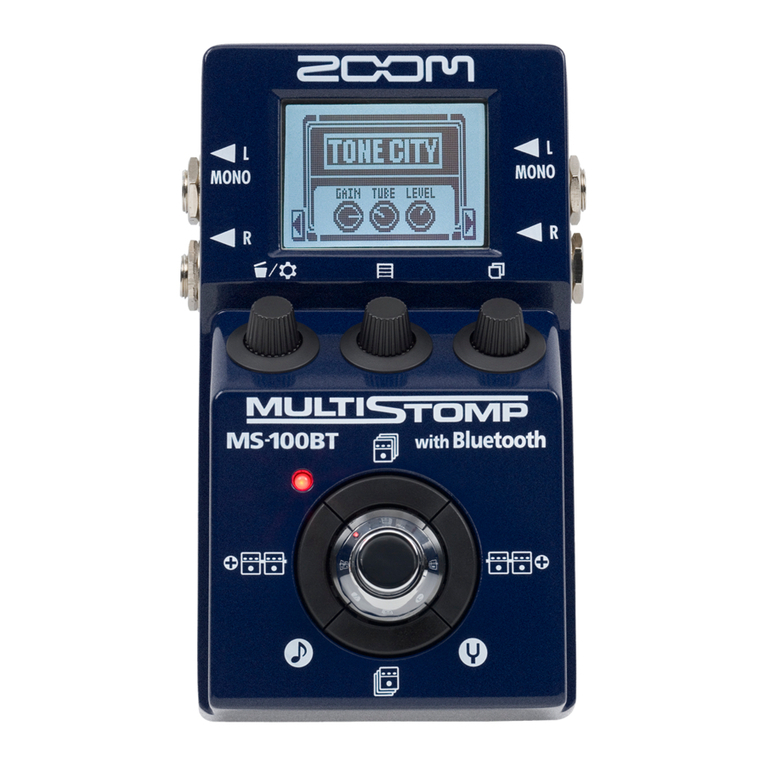
Zoom
Zoom MULTISTOMP MS-100BT General instructions
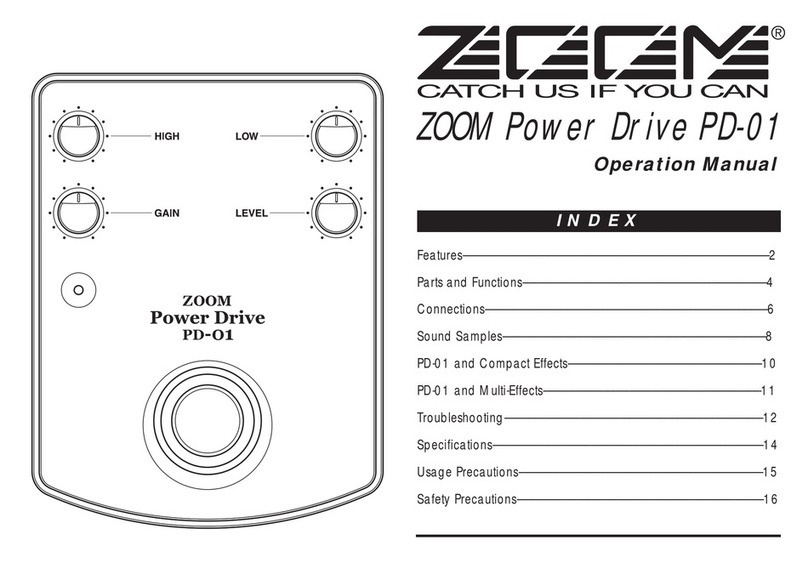
Zoom
Zoom Power Drive PD-01 User manual

Zoom
Zoom G1N EXT User manual
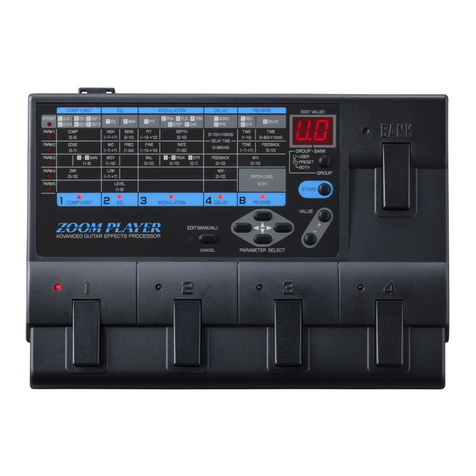
Zoom
Zoom 2020 User manual
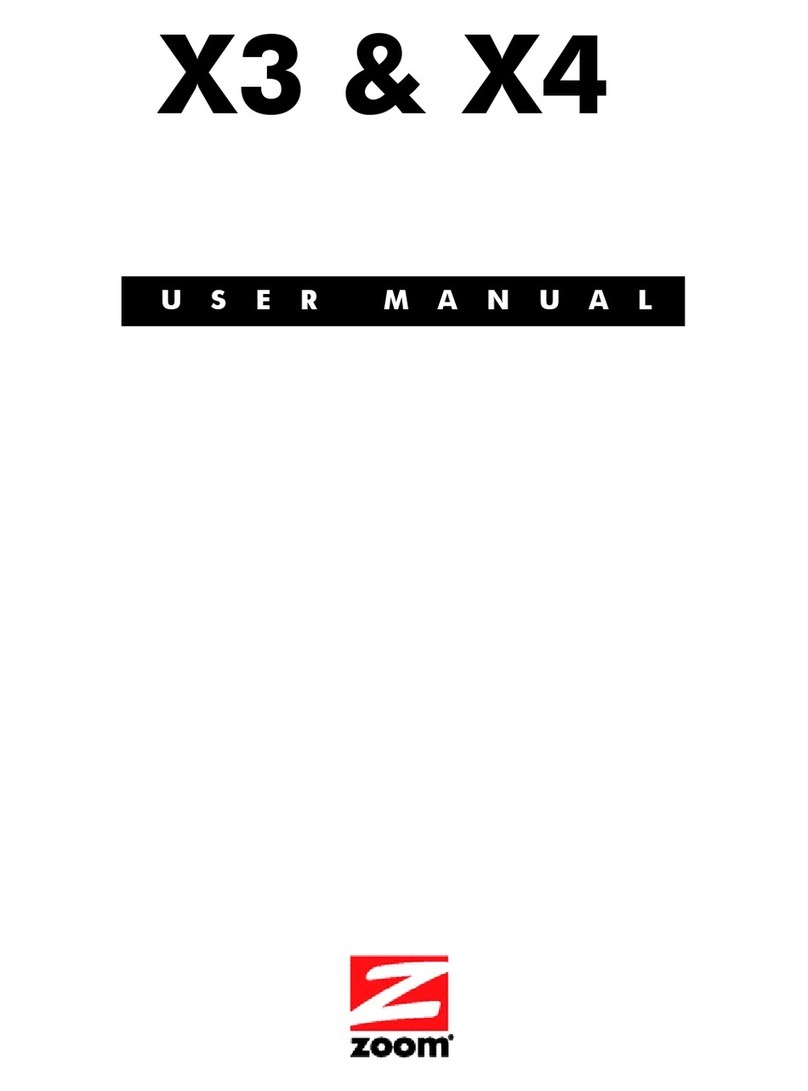
Zoom
Zoom ADSL X3 User manual

Zoom
Zoom 508 User manual

Zoom
Zoom MULTISTOMP MS-50G+ User manual

Zoom
Zoom G2 User manual
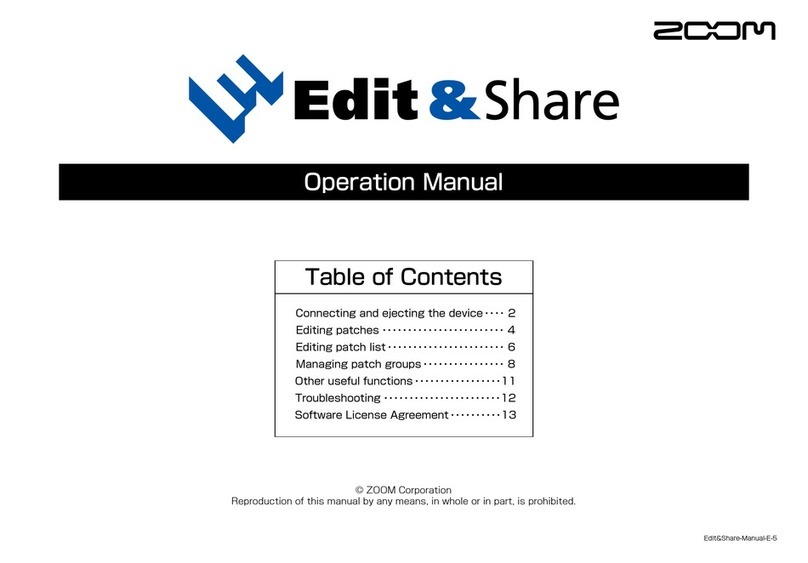
Zoom
Zoom Edit&Share User manual

Zoom
Zoom 506 BASS User manual
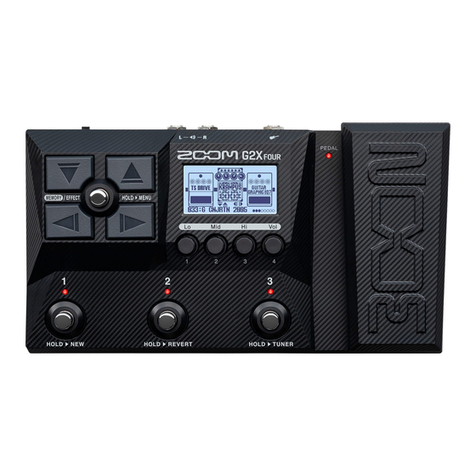
Zoom
Zoom G2 User manual

Zoom
Zoom g9.2tt User manual

Zoom
Zoom B2.1u User manual

Zoom
Zoom ACOUSTIC 504 II User manual
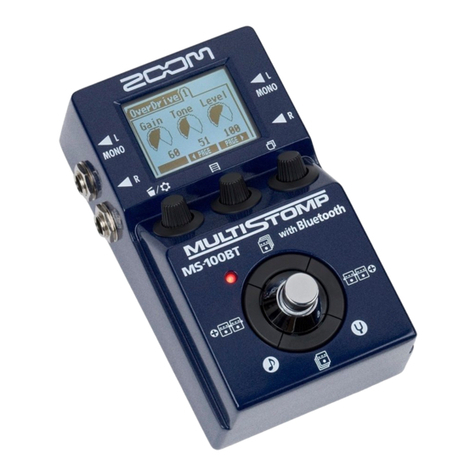
Zoom
Zoom MULTISTOMP MS-100BT User manual
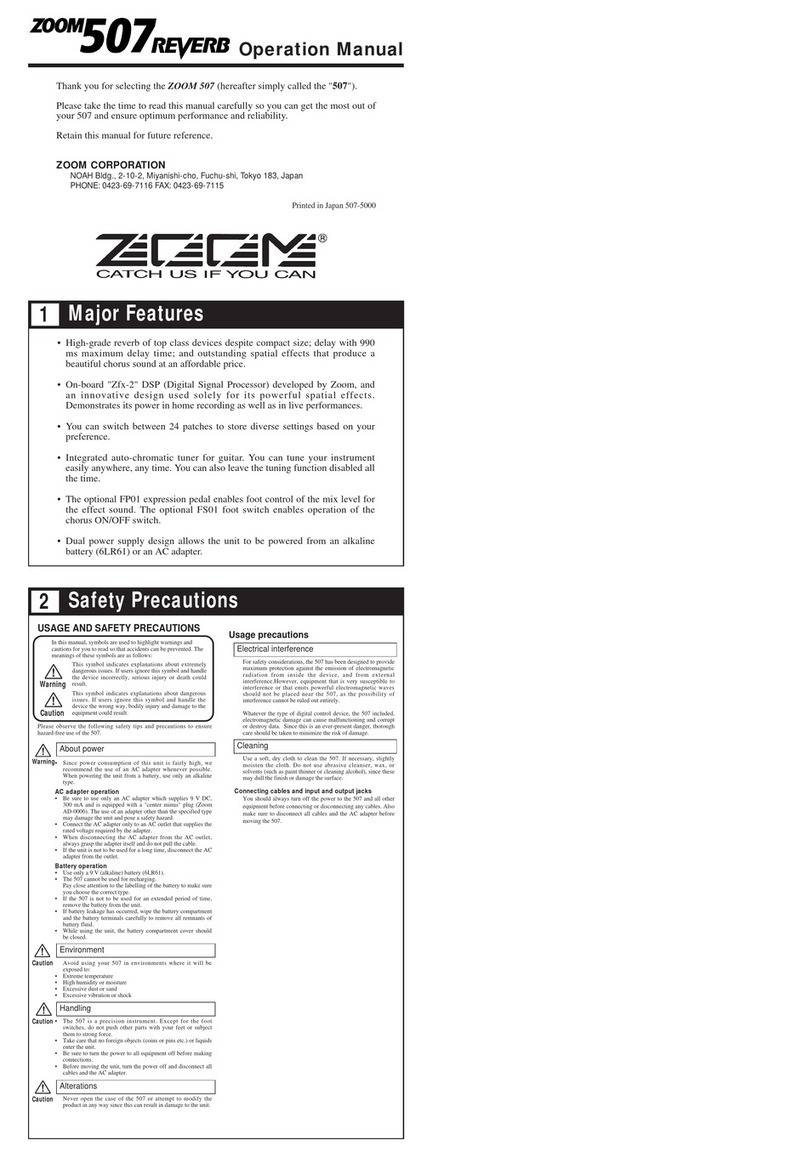
Zoom
Zoom 507 REVERB User manual

Zoom
Zoom 504 Acoustic User manual

Zoom
Zoom G5n User manual


